The patient was a 22-year-old Japanese woman who complained of a gummy smile. She had several other orthodontic problems, including crowding of the maxillary anterior teeth, retroclination of the maxillary central incisors, excessive maxillary incisor display, a deep overbite, Class II dental relationships, a Class II profile, and a long face. Two options for the correction of these problems were proposed. The first option was to extract the maxillary first premolars to correct the Class II relationship and implant a miniscrew to correct the gingival display; the second option was to place 2 miniplates for distalization of the maxillary molars and a miniscrew to correct the gingival smile without premolar extractions. The patient chose the second option. After placing a preadjusted bracketed system, 2 miniplates were placed in the zygomatic buttresses bilaterally with monocortical screws, and 1 miniscrew was fixed between the root apices of the maxillary central incisors. Distalization and intrusion of the maxillary molars and intrusion of the maxillary incisors were simultaneously started with those temporary skeletal anchorage devices functioning as absolute orthodontic anchors. The total treatment period was approximately 22 months. Her orthodontic problems were corrected. According to the cephalometric evaluation, the entire maxillary dentition was significantly distalized, and her maxillary incisors were successfully intruded, with the mandible showing a slight counterclockwise rotation. Thanks to the temporary anchorage devices combined with miniplates and a miniscrew, we were able to predictably achieve her treatment goals without premolar extractions, orthognathic surgery, and the need for patient compliance.
The prevalence of Angle Class II Division 2 malocclusion is relatively low in comparison with other malocclusions. This malocclusion is generally characterized by retroclination of the maxillary incisors, a deepbite, and an obtuse interincisal angle. In the treatment of a Class II Division 2 malocclusion, the improvement of a deepbite with a gummy smile is a challenging treatment objective. Conventional orthodontic methods, such as an intrusive arch, have been used to reduce overbite, often resulting in undesirable extrusion and flaring of the posterior teeth. The clockwise rotation of the mandible caused by the extrusion of the posterior teeth worsens the Class II convex profile in many patients and also leads to an increase in the incidence of relapse for adults. Extraoral appliances to reduce overbite, such as the J-hook, are effective in controlling the anchorage, but it is difficult to predict the final result in uncooperative patients. There is a clear need for a procedure for patients with deepbite and excessive gingival display resulting a gummy smile that effectively intrudes the maxillary incisors without undesirable side effects and without their cooperation.
The successful use of temporary skeletal anchorage devices (TSADs) as absolute anchorage to reduce overbite in nongrowing patients has been reported. However, no case report has detailed the simultaneous intrusion of the anterior teeth to correct a gummy smile and distalization of the maxillary posterior teeth to correct molar relationships.
In this case report, we present the nonextraction treatment of an adult with a Class II Division 2 malocclusion whose deep overbite and gummy smile were predictably corrected using TSADs combined with miniplates and a miniscrew on the basis of a goal-oriented approach.
Diagnosis and etiology
The patient, a 22-year-old Japanese woman, had a convex profile, a Class II malocclusion, and excessive display of her maxillary incisors ( Fig 1 ). Her chief complaint was a gummy smile. A short upper lip and hyperactivity of the elevator muscles of the upper lip were found in the clinical examination and are clearly shown in her pretreatment smiling photograph. Intraorally, she had Class II molar relationships bilaterally, a deep overbite, retroclination of the maxillary incisors, a high canine on the left hand side, and anterior crowding in the maxilla ( Fig 2 ).
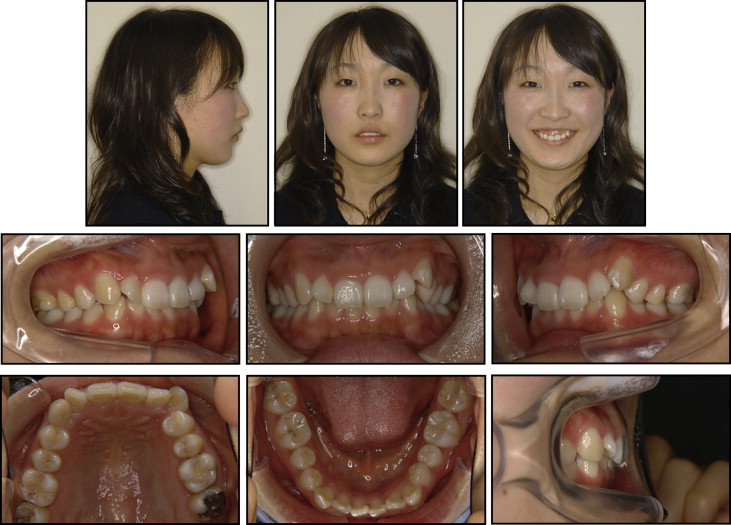
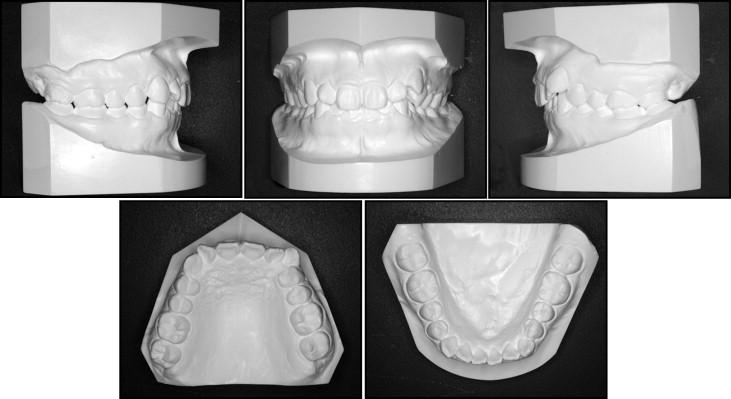
The initial lateral cephalometric radiograph was taken in natural head position with relaxed lip posture and at centric relation ( Fig 3 ). The cephalometric template analysis ( Fig 4 ) and the cephalometric measurements ( Table ) clearly indicated that she had a skeletal Class II profile, retroclination of the maxillary central incisors, and excessive eruption of the maxillary incisors. The panoramic radiograph showed her bilateral mandibular third molars. The level of alveolar bone crest was within the normal range, and she had healthy periodontal tissues ( Fig 5 ).
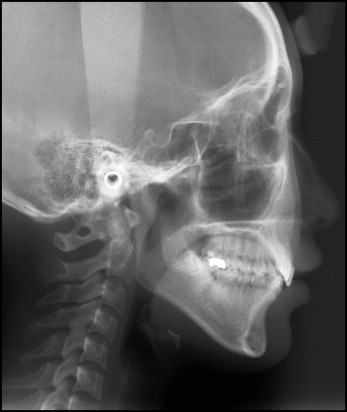
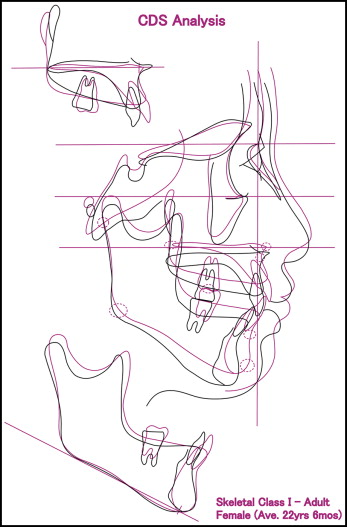
| Pretreatment | Posttreatment | Retention 2 y | Norm | |
|---|---|---|---|---|
| SNA (°) | 76 | 75 | 75 | 82 |
| SNB (°) | 69 | 69 | 69 | 80.5 |
| ANB (°) | 7 | 6 | 6 | 1.5 |
| AB to occlusal plane (mm) | 4 | 3 | 4 | – |
| U1 to SN (°) | 77.5 | 94 | 90.5 | 107.5 |
| SN-OP (°) | 27 | 25 | 24 | 16 |
| FMA (°) | 35.5 | 35 | 35 | 29 |
| IMPA (°) | 91 | 96 | 97 | 96.5 |
| FMIA (°) | 53.5 | 49 | 47 | 54.5 |
| Interincisal angle (°) | 145.5 | 124 | 126 | 127 |
| Upper lip (mm) | 0 | −1 | −1 | −1 |
| Lower lip (mm) | 1 | 0 | −0.5 | 0 |
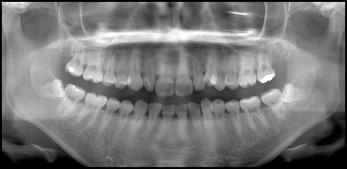
Treatment objectives
The principal treatment objectives were to achieve optimal overjet and overbite, improve her gummy smile, and establish Class I canine and molar relationships. Figure 6 shows her treatment goal on the basis of the cephalometric prediction. According to her treatment goal, the maxillary central incisors and first molars needed to be intruded by 4.0 and 1.0 mm, respectively. The intrusion of the entire maxillary dentition was expected to induce a counterclockwise rotation of the mandible, in effect improving her Class II profile and significantly reducing her large interlabial gap. In addition, a 4.0-mm average bilateral distalization of the maxillary molars was needed to correct her Class II dentition.
Treatment objectives
The principal treatment objectives were to achieve optimal overjet and overbite, improve her gummy smile, and establish Class I canine and molar relationships. Figure 6 shows her treatment goal on the basis of the cephalometric prediction. According to her treatment goal, the maxillary central incisors and first molars needed to be intruded by 4.0 and 1.0 mm, respectively. The intrusion of the entire maxillary dentition was expected to induce a counterclockwise rotation of the mandible, in effect improving her Class II profile and significantly reducing her large interlabial gap. In addition, a 4.0-mm average bilateral distalization of the maxillary molars was needed to correct her Class II dentition.
Treatment alternatives
The development of TSADs has made it possible to correct a gummy smile successfully without surgery. Orthognathic surgery is no longer the first option for the correction of a gummy smile. The patient was given 2 nonsurgical alternatives: the first option was to extract the maxillary first premolars for Class II correction and implant a miniscrew for gummy simile correction, and the second option was to place 2 miniplates for distalization of the maxillary molars and a miniscrew for gummy smile correction without premolar extractions.
Since she was reluctant to have her 2 maxillary premolars extracted, she decided on the second option.
Stay updated, free dental videos. Join our Telegram channel

VIDEdental - Online dental courses


